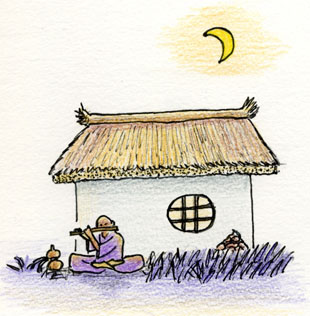Extracts from a 1996 paper by Robert K.C. Forman, Hunter College, New York
Mystical experiences may represent just such a simple form of human consciousness. Usually our minds are an enormously complex stew of thoughts, feelings, sensations, wants, snatches of song, pains, drives, daydreams and, of course, consciousness itself more or less aware of it all. To understand consciousness in itself, the obvious thing would be to clear away as much of this internal detritus and noise as possible. It turns out that mystics seem to be doing precisely that. The technique that most mystics use is some form of meditation or contemplation. These are procedures that, often by recycling a mental subroutine,2 systematically reduce mental activity. During meditation, one begins to slow down the thinking process, and have fewer or less intense thoughts. One’s thoughts become as if more distant, vague, or less preoccupying; one stops paying as much attention to bodily sensations; one has fewer or less intense fantasies and daydreams. Thus by reducing the intensity or compelling quality of outward perception and inward thoughts, one may come to a time of greater stillness. Ultimately one may become utterly silent inside, as though in a gap between thoughts, where one becomes completely perception- and thought-free. One neither thinks nor perceives any mental or sensory content. Yet, despite this suspension of content, one emerges from such events confident that one had remained awake inside, fully conscious. This experience, which has been called the pure consciousness event, or PCE, has been identified in virtually every tradition. Though PCEs typically happen to any single individual only occasionally, they are quite regular for some practitioners.3 The pure consciousness event may be defined as a wakeful but contentless (non-intentional) consciousness.
from Christian mystical literature,10 St. Teresa of Avila writes of what she calls the ‘orison of union’:
During the short time the union lasts, she is deprived of every feeling, and even if she would, she could not think of any single thing. . . She is utterly dead to the things of the world . . . I do not even know whether in this state she has enough life left to breathe. It seems to me she has not; or at least that if she does breathe, she is unaware of it. . . The natural action of all her faculties [are suspended]. She neither sees, hears, nor understands (James, 1902/1983, p. 409).11
Several key features of this experience jump out. First, Teresa tells us that one reaches this ‘orison of unity’ by gradually reducing thought and understanding, eventually becoming ‘utterly dead’ to things, encountering neither sensation, thought nor perceptions. One becomes as simple as possible. Eventually one stops thinking altogether, not able to ‘think of any single thing . . . arresting the use of her understanding . . . utterly dead to the things of the world’. And yet, she clearly implies, one remains awake.12
Meister Eckhart describes something similar as the gezucken, rapture, of St. Paul, his archetype of a transient mystical experience:
. . . the more completely you are able to draw in your powers to a unity and forget all those things and their images which you have absorbed, and the further you can get from creatures and their images, the nearer you are to this and the readier to receive it. If only you could suddenly be unaware of all things, then you could pass into an oblivion of your own body as St Paul did, . . . In this case . . . memory no longer functioned, nor understanding, nor the senses, nor the powers that should function so as to govern and grace the body . . . In this way a man should flee his senses, turn his powers inward and sink into an oblivion of all things and himself (Walshe, 1982, p. 7).
Like St. Teresa, Eckhart specifically asserts the absence of sensory content (‘nor the senses’), as well as mental objects (‘devoid of’ memory, understanding, senses, etc.). One becomes oblivious of one’s ‘own body’ and ‘all things’. In short one becomes ‘unaware of all things’, i.e. devoid of all mental and sensory content.
The absence of thought and sensation is repeated in the following passage from the Upanishads when describing the state these early Hindu texts call turiya, the ‘fourth’.
Verily when a knower has restrained his mind from the external, and the breathing spirit (prana) has put to rest objects of sense, thereupon let him continue void of conceptions. Since the living individual (jiva) who is named ‘breathing spirit’ has arisen here from what is not breathing spirit, therefore, verily, let the breathing spirit restrain his breathing spirit in what is called the fourth condition (turiya) — Maitri Upanishad 6:19 (Hume, 1931, p. 436).
Read more...













